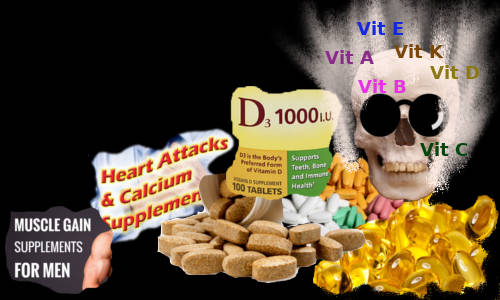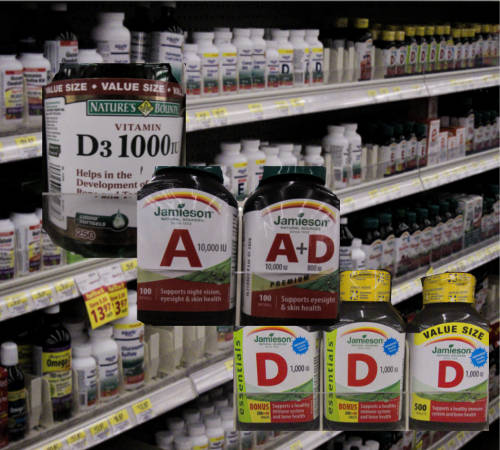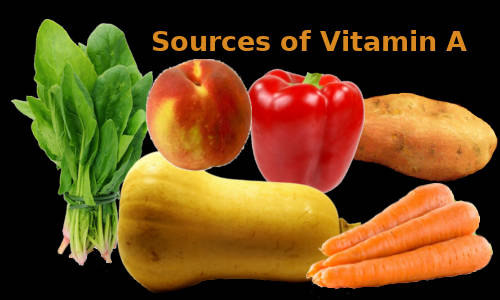NutriScience for everybody
The Risks of Multi-Vitamin Intake
Vitamins are micronutrients absolutely essential in the human diet. Most of the vitamins cannot be synthesized by the body tissues. Vitamins as supplements should be taken only after having a complete nutritional assessment. Most of people that are taking vitamins are victims of the fashion of the advertisement claims because they are convinced to intake vitamins in form of tables or capsules for ‘improving their health’. Some dietary supplements not only do not reduce, but paradoxically increase the risk of diseases when mainly the dosage exceeds the recommended daily allowance several fold. Uncontrolled intake of products that in normal dosage are considered to be safe may bring opposite and undesirable results.

Vitamins are a group of organic nutrients, required in small quantities for a variety of biochemical functions that, generally, cannot be synthesized by the body and must therefore be supplied in the diet[2]. Most of the vitamins are absolutely essential in the human diet because the body tissues cannot synthesize them. Two notable exceptions are vitamin D and niacin. Cutaneous synthesis of vitamin D depends on adequate exposure of the skin to sunlight, and the synthesis of niacin depends on a sufficient intake of its amino acid precursor, tryptophan, bound within protein[1]. There are two types of vitamins, water soluble and fat soluble vitamins. Water-soluble vitamins dissolve in water and are not stored in the body, they are eliminated in urine. Fat soluble vitamins are stored in the body for prolonged periods and as a class deal with the regulation of protein synthesis[4]. Vitamins B and C are water soluble while vitamins A, D, E and K are fat soluble.
Use of multivitamin-multimineral supplements is widespread in the world. In USA it is estimated that more of 50% of the population take nutritional supplements regularly and about 20% take multivitamins. Self dosing is a bad idea because many supplements are toxic at high level. People should be taken vitamins as supplements only after having a complete nutritional assessment. Vitamins as supplements only should be taken when food can not satisfy the daily nutritional requirements, to support increased nutritional needs at specific life stage such as pregnant or breast feeding women, newborns or elderly people and/or to reduce disease risk under certain medical condition such as persons at risk of having osteosporosis.
The intake of vitamin supplements have become not only a readily available and simple method to replenish the deficiencies of individual vitamins, but also a fashion propagated by media and manufacturers. Falling victim to that fashion as well as to the advertisement claims, many people are convinced that the intake of vitamins in the form of tablets or capsules can fully meet their demand and protect them from suffering from numerous more or less hazardous disorders[3].
The misuse of vitamins is not without its safety concerns. The amount of vitamins or nutrients in multivitamins should not exceed the recommended daily allowance. For vitamins to cause side effects the intake should exceed recommended daily allowance several fold[4].
It turns out that some dietary supplements not only do not reduce, but paradoxically increase the risk of diseases. Dosage is another problem, since uncontrolled intake of products considered to be safe may bring about opposite results[3]. One of the examples is the intake of vitamin A in excessive amounts that cause toxicity. There is only a limited capacity to metabolize vitamin A, and excessive intakes lead to accumulation beyond the capacity of binding proteins, so that unbound vitamin A causes tissue damage. Symptoms of toxicity affect the central nervous system (headache, nausea, ataxia, and anorexia, all associated with increased cerebrospinal fluid pressure); the liver (hepatomegaly with histologic changes and hyperlipidemia); calcium homeostasis (thickening of the long bones, hypercalcemia, and calcification of soft tissues); and the skin (excessive dryness, desquamation, and alopecia)[2].
Only in some few cases vitamins could be beneficial at determinate higher doses. Several studies have shown that vitamin E in doses higher than recommended daily allowance had cardio protective effect. Low density lipoprotein concentration decreased significantly in blood taken from subjects receiving >200 IU a day but not in those on < 200 IU a day[4].
A recommended dietary allowance (RDA) of a nutrient is the average daily dietary intake level that is sufficient to meet the requirement of nearly all (97 – 98%) apparently healthy individuals in a particular life stage and gender group[1]. Before to intake vitamins, people should be sure that they diet is micronutrient deficient. The only way to know if the diet is deficient in nutrient it is to perform a complete professional nutritional assessment.
_______[1] Ball, George F.M. 2006. Vitamins in foods. Analysis, bioavailability, and stability. CRC Taylor & Francis.
[2] Murray, Robert K. Et al. 2000. Harper’s illustrated biochemistry. Mc Graw Hill.
[3] Marosz, Agnieszka and Chlubek, Dariusz. 2014. The risk of abuse of vitamin supplements. Annales Academiae Medicae Stetinensis. 60, 1, 60-64.
[4] Lt Col AS Menon et al. 2008. Multivitamins: Use or misuse? MJAFI; 64 : 263-267.

The Vitamin A
Vitamin A is a fat soluble vitamin that under normal condition it is mostly stored in the liver. Vitamin A is an essential micronutrient for vision, reproduction and integrity of membrane structures, the normal functioning of body cells, growth and development. Vitamin A deficiency, as well as vitamin A excess, produces a number of malformations of the embryo of all vertebrates. To avoid both deficiency and excess of intake of vitamin A it is strongly recommended to consume daily fresh vegetables that are rich in sources of vitamin A such as red peppers, carrots, yellow squash, spinach, sweet potatoes and peach.

Vitamin A is a fat soluble vitamin. Under normal conditions, over 90% of vitamin A is stored in the liver, mostly as retinyl palmitate This is why fish and animal livers (and their oils, like cod liver oil) are such potent sources of vitamin A[5].
Vitamin A is an essential nutrient for vision, reproduction and integrity of membrane structures, the normal functioning of body cells, growth and development[2]. With an estimated 250,000 to 500,000 children becoming blind annually, vitamin A deficiency constitutes the leading preventable cause of blindness in low- and middle-income nations[4]. Causes of vitamin A deficiency include inadequate intake, impaired absorption or storage, and poor conversion of carotene to active vitamin A[3].
Several million capsules, each with doses of 25,000 to 200,000 IU of vitamin A (7.5–60 mg of retinol), are consumed each year in a number of countries. It is important to note that there have been no case reports of birth defects from vitamin A exposure due to dietary sources[1] such as red peppers, carrots, yellow squash, spinach, sweet potatoes and peach, that are the main vegetable sources rich in vitamin A.
Vitamin A exists in the plant world only in the form of precursor compounds, such as β-carotene. This is a member of a large class of naturally occurring carotenoids, with about 50 compounds with vitamin A activity[1]. High intakes of carotenoids do NOT lead to abnormally high vitamin A concentrations or symptoms of hypervitaminosis A [1]. The toxicities of carotenoids are considered low, and circumstantial evidence suggests that β-carotene intakes of as much as 30 mg/day are without side effects other than the accumulation of the carotenoid in the skin, with consequent yellowing of the skin (carotenodermia). Regular, high intakes of β-carotene can lead to accumulation in fatty tissues[6]. Hypercarotenemia has been seen in people who consume large quantities of food rich in β-carotene, such as carrots[1]. According with the USDA database list food, 100 grams of carrots content 8.285 mg of β-carotene.
Hypervitaminosis A in humans it is manifest after single large doses (>660,000 IU for adults, >330,000 IU for children), or after doses exceeding 100,000 IU/day have been taken for several months and chronic hypervitaminosis A occurs with recurrent exposures exceeding 12,500 IU (infants) to 33,000 IU (adult)[6]. An analysis of results from more than 72,000 postmenopausal women in the Nurse’s Health Study114 found that individuals reporing intakes of at least 2000 IU/d had twice the risk of hip fracture due to mild or moderate trauma than those reporting intakes less than 500 IU/d[6].
Among the Symptoms of vitamin A toxicity include joint pain, decalcification, and fragility of bone. Increased intracranial pressure produces pseudo brain tumor symptoms. Red blood cells lose hemoglobin, and bleeding can occur easily. Nervous system symptoms include irritability, restlessness, fatigue, anorexia, and muscle weakness[3].
Vitamin A deficiency, as well as vitamin A excess, produces a number of malformations of the embryo of all vertebrates. These abnormalities involve almost all organs in the body (e.g., the central nervous system, eye, face, dentition, ear, limbs, urogenital system, skin, lungs, heart, and hematopoietic system, as well as body axis development)[1]. The best way to get a safe level of vitamin A in the body is eating vegetables rich in precursors of vitamin A.
Acording with the Recommended Daily Allowance (RDA) the dosage for infants until 6 months is 400 mcg(~1300 IU), for infants 6 to 12 months is 500 mgc(~1660 IU), for children 4 to 8 years is 400 mcg(1300 IU), 9 to 13 years is 600 mcg(2000 IU), for men older than 14 years is 900 mcg (3000 IU) and women older than 14 is 700 mcg(2300IU).
| Sources of Vitamin A | ||
| Vegetables and Fruits | Vitamin A IU/100 g |
β-Carotene mcg/100 g |
| Spinach, raw | 9377 | 5626 |
| Spinach, boiled | 10481 | 6188 |
| Peppers sweet, red, raw | 3131 | 1624 |
| Peppers sweet, red, boiled | 2941 | 1525 |
| Carrots, raw | 16706 | 8285 |
| Carrots, boiled | 17033 | 8332 |
| Sweet potatoes, boiled | 6438 | 3863 |
| Peaches, yellow, raw | 326 | 162 |
Source: USDA Database List Food.
___________
[1]Blomhoff, Rune. 2001. Vitamin A and carotenoid toxicity. Food and Nutrition Bulletin, vol. 22, no. 3.
[2] Karuma, Irungham et al. 2013. Hypervitaminosis/vitamin poisonin in animal. The North-Est Veterinarian, vol XIII Nro.2.
[3] Watts, David L. 1991. The nutritional relationships of Vitamin A. Journal of Orthomolecular Medicine Vol. 6, No.1.
[4] Tan, Libo. 2015. Vitamin A. Linus Pauling Institute. http://lpi.oregonstate.edu/book/export/html/119.
[5] Sommer, Alfred et al. 1996. Vitamin A deficiency. Health, survival and vision. Oxford University Press.
[6] Combs, Gerald F. 2008. The vitamins. Fundamental aspects in nutrition and health. Elsevier.
Vitamin D Deficiency
is a Serious Problem in the World
Vitamin D deficiency is now recognized as a pandemic with more than half of the world’s population currently at risk. Very few foods naturally contain vitamin D, and foods that are fortified with vitamin D are often inadequate to satisfy the requirement of the population. Vitamin D is a very important micronutrient because it exerts most of its benefit through calcium homeostasis and prevention of bone disease such as rickets, osteomalacia, and osteoporosis, it also has been shown to induce cellular differentiation, inhibit angiogenesis, and possibly reduce the invasiveness and metastatic potential of tumors. People should intake daily vitamin D as supplement in the recommended daily allowance (RDA) dosage of the Standing Committee of the US Department of Agriculture. Toxicity of vitamin D can result only from chronic oversupplementation of vitamin D, but not from unlimited exposure to sunshine or the consumption of usual diets or from the right required dosage from supplements.

Vitamin D deficiency is now recognized as a pandemic with more than half of the world’s population currently at risk. It is estimated that one billion people worldwide have either vitamin D deficiency of insufficiency. The major cause of vitamin D deficiency is the lack of appreciation that sun exposure in moderation is the major source of vitamin D for most humans. Very few foods naturally contain vitamin D, and foods that are fortified with vitamin D are often inadequate to satisfy either a child’s or an adult’s vitamin D requirement[2]. Most of the time, professional nutritional assessment tests are revealing deficient amount of vitamin D in the diets of the patients. A blood test is required for evaluating the deficiency and the level of vitamin D. The test measures the level of calcidiol (25-Hydroxyvitamin D or 25[OH]D) circulating in blood. The normal level of calcidiol in people that lives in sunny countries is 135-225 nmoL/L or 54-90 ng/mL[5]
Vitamin D deficiency causes rickets in children and will precipitate and exacerbate osteopenia, osteoporosis, and fractures in adults. Also it has been associated with increased risk of common cancers, autoimmune diseases, hypertension, and infectious diseases[2]. Vitamin D plays an essential role in the regulation of metabolism, calcium and phosphorus absorption of bone health[5]. Although vitamin D previously was thought to exert most of its benefit through calcium homeostasis and prevention of bone disease (ie, rickets, osteomalacia, and osteoporosis), it also has been shown to induce cellular differentiation, inhibit angiogenesis, and possibly reduce the invasiveness and metastatic potential of tumors.[1]. Vitamin D analogs have been reported to reduce tumor volume in patients with inoperable hepatocellular carcinoma and to increase apoptosis of hepatocarcinoma cells by 21.4%[6].
Vitamin D is the generic name for compounds exhibiting the biological activity of cholecalciferol (vitamin D3)[4]. There are 2 main forms of vitamin D: vitamin D3 (cholecalciferol) and vitamin D2 (ergocalciferol). Vitamin D3 is formed in the skin, after exposure to ultraviolet B radiation and Vitamin D2 is obtained through irradiation of ergosterol in plants, analogous to human production from sunlight[1].
Only a small number of foods naturally contain vitamin D, and even those fortified with vitamin D are frequently insufficient to fulfill the requirement for children or adults, unless large amounts are consumed[1]. Multiple preparations of vitamin D and its metabolites are commercially available for supplement use. The two most common supplements are ergocalciferol (vitamin D2) and cholecalciferol (vitamin D3). Some studies suggest that vitamin D3 increases serum 25[OH]D more efficiently than vitamin D2[5]. Also cod liver oil is commercially available but it is not recommended its use as a supplement of vitamin D because it contains excessive amounts of active vitamin A (preformed retinol). Researchers think that vitamin A in cod liver oil is excessive and actually antagonizes vitamin D by inhibiting the binding of its active form to DNA and thus preventing its ability to regulate the expression of vitamin D-responsive genes[8].
The 1997 recommended daily allowance (RDA) Standing Committee of the US Department of Agriculture, therefore, recommends 200 IU/d for children and younger adults less than 50 years old, 400 IU/d for older adults older than 50 years old, and 600 to 800 IU/d for the elderly older than 70 years old.
Certain populations are at higher risk for vitamin D deficiency such as obese individuals have lower levels of 25(OH)D when compared with non-obese individuals. The increase in serum vitamin D3 was 57% less in obese than in non-obese individuals 24 hours after a single suberythemic dose of ultraviolet B. Because vitamin D is fat soluble and readily stored in adipose tissue, it is possible that subcutaneous fat in obese individuals sequestered more of the vitamin D3 synthesized in the skin[3].
______
[1] Stechschulte, Sarah A. Et al. 2009. Vitamin D: Bone and Beyond, Rationale and Recommendations for Supplementation. The American Journal of Medicine, Vol 122, No 9.
[2]Holick, Michael F. And Chen, Tai C. 2008. Vitamin D deficiency: a worldwide problem with health consequences. Am J Clin Nutr 2008;87(suppl):1080S–6S. Printed in USA.
[3] Ball, George F.M. 2006. Vitamins in foods. Analysis, bioavailability, and stability. CRC Taylor & Francis.
[4] Borel, P. Et al. 2016. Vitamin D bioavailability: State of the art. Critical Reviews in Food Science and Nutrition, 55:1193–1205.
[5] Alshahrani, Fahad and Aljohani, Naji. 2013. Vitamin D: Deficiency, Sufficiency and Toxicity. Nutrients, 5, 3605-3616.
[6] Luong , Khanh vinh quoc and Nguyen, Lan Thi Hoang. 2010. The beneficial role of vitamin D and its analogs in cancer treatment and prevention. Critical Reviews in Oncology/Hematology 73, 192–201.
[7] Muhammad, Ilias et al. 2010. Maca (Lepidium meyenii).
[8] Important Cod Liver Oil Update. 2008.https://articles.mercola.com/sites/articles/archive/2008/12/23/important-cod-liver-oil-update.aspx
Antiseptic Properties of Cod Liver Oil
According with The Indian Medical Gazette published in June 1936, raw cod liver oil has healing and antiseptic properties that could be very useful for treating wounds.
Following I reproduce the three cases published in the mentioned publitation as illustrative examples:
1. A boy, aged 11, fell down from a bicycle, and had a small punctured wound. The probe revealed a foreign body; operation was attempted. But the foreign body having lodged deeply and being afraid of injuring the knee joint I left it to nature. The pus was coming freely and pain was so severe that the patient had no sleep for a week. I started cod-liver oil dressings, the pus became gradually less and the pain also disappeared. After a few days when the wound began to heal two twigs half an inch in size came out of the wound and the patient made an uneventful recovery.
2. A kahar boy, aged 19 years, came with stoppage of urine. On examination a big stone was discovered. A suprapubic cystotomy had to be performed. Aseptic dressings were applied. Every part of the wound healed up, except a small hole which was discharging drops of urine. First chlorogen dressings were applied with no result and then acriflavine dressings were applied, still the hole did not heal. Then cod-liver oil dressings were applied. I am glad to say within a week the wound began to heal and the hole closed up totally within 10 days' time.
3. This was a case of tiger bite so severe in nature that the patient was drowsy with fever of 101 ?F., dryness of the mouth and headache. There were five bites on the top of the shoulder joint, each bite communicating with the other. The wounds were cauterized with carbolic acid and after giving him injections of tetanus serum and polyvalent anti-streptococcic serum the wounds were thoroughly washed with carbolic lotion and hydrogen peroxide, and chlorogen dressings were applied. The whole night, the man was in awful pain and in the morning when dressings were being changed a huge quantity of serosanguineous pus flew out of the channels formed by the upper and lower teeth meeting each other during the bite. I started cod-liver oil dressings immediately and I am glad to say the patient felt the soothing effect of the oil, had a peaceful night and next day the condition of the wound was healthier than before with very little discharge of pus. The patient steadily progressed and was discharged quite cured within 15 days. These cases are very dangerous inasmuch as the tiger's teeth are always badly infected, besides when biting it crushes a large amount of the tissues which by decomposition generally kills the patient by causing septicaemia before the healing sets in. I generally get such cases and this is the first time when I have had such a good result.
I have many instances in which antiseptic dressings with chlorogen and acriflavine have failed and the last successful resort has been cod-liver oil. I am consequently convinced of the fact that treatment by cod-liver oil in suitable cases of surgery are far more beneficial and less costly than such things as chlorogen, eusol, acriflavine, etc. As to why this raw oil should have such quick effect in healing all kinds of wounds I have no definite idea. All that suggests itself to me is that it has got some properties by which no germs of disease can flourish in it and, secondly, there are certain vitalizing or life-giving properties known as vitamins which play an important part in helping to develop the tissues at a rapid rate and thus granulating the wounds quickly.
Warning
It is NOT recommended intake Cod Liver Oil as Vitamin D supplement because it contains excessive amounts of active vitamin A (preformed retinol).
Researchers think that vitamin A in cod liver oil is excessive and actually antagonizes vitamin D by inhibiting the binding of its active form to DNA and thus preventing its ability to regulate the expression of vitamin D responsive genes.
Useful information
Vitamin D
Recommended Daily Allowances (RDA) |
||||||||
Age |
Male |
Female |
Pregnancy |
Lactation |
||||
mcg |
IU |
mcg |
IU |
mcg |
IU |
mcg |
IU |
|
| 0-12 months | 10 |
400 |
10 |
400 |
||||
| 1-13 years | 15 |
600 |
15 |
600 |
||||
| 14-18 years | 15 |
600 |
15 |
600 |
15 |
600 |
15 |
600 |
| 19-50 years | 15 |
600 |
15 |
600 |
15 |
600 |
15 |
600 |
| 51-70 years | 15 |
600 |
15 |
600 |
||||
| >70 years | 20 |
800 |
20 |
800 |
||||
Source: https://ods.od.nih.gov/factsheets/VitaminD-HealthProfessional/
Warning
Toxicity of vitamin D can result from chronic oversupplementation of vitamin D, but not from unlimited exposure to sunshine or the consumption of usual diets. The physiological basis for toxicity is bone demineralization, causing increased serum calcium levels[1].
The excess calcium is deposited in the kidneys, causing hypertension, cardiac insufficiency, and renal failure[1]. So, always intake the vitamin D in the recommended amount for your age by the US Department of Agriculture and the advise of your physician.
[1] Ball, George F.M. 2006. Vitamins in foods. Analysis, bioavailability, and stability. CRC Taylor & Francis.
| Foods rich in Vitamin D | UI Vit. D/100 g |
| Mushrooms, brown, italian or crimini, exposed to ultraviolet light, raw (Agaricus bisporus) | 1276 |
| Mushrooms, portabella, exposed to ultraviolet light, raw (Agaricus bisporus) | 1135 |
| Mushrooms, portabella, exposed to ultraviolet light, grilled (Agaricus biporus) | 524 |
| Mushrooms, maitake, raw (Grifola frondosa) | 1123 |
| Mushrooms, white, exposed to ultraviolet light, raw | 1046 |
| Fish, carp, raw (Cyprinus carpio) | 988 |
| >Salmon, sockeye, canned, solids, without skin and bones | 859 |
| Fish, trout, rainbow, farmed, cooked, dry heat | 670 |
| Fish, mackerel, Atlantic, raw (Scomber scombrus L.) | 643 |
| Fish, trout, rainbow, farmed, raw (Salmo gairdnen Richardson) | 635 |
| Fish, salmon, sockeye, raw | 563 |
| Fish, salmon, Atlantic, farmed, cooked, dry heat | 526 |
| Fish, salmon, Atlantic, pink, cooked, dry heat | 522 |
| Fish, sardine, Atlantic, canned in oil, draineed solids with bone (Clupea harengus harengus L.) |
193 |
| Fish oil, cod liver (NOT recommended, see warning) | 10000 |
______
eidos-project.net © 2016- 2025